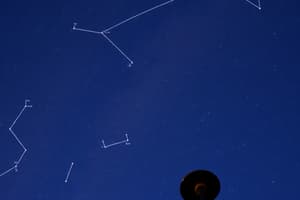Podcast
Questions and Answers
What are constellations?
What are constellations?
- Areas on the celestial sphere where planets are visible.
- Areas on the celestial sphere where stars are not visible.
- Areas on the celestial sphere where stars are randomly scattered.
- Areas on the celestial sphere where a group of visible stars forms a pattern representing an animal, mythological subject, or inanimate object. (correct)
Which organization formally accepted the modern list of 88 constellations?
Which organization formally accepted the modern list of 88 constellations?
- Russian Space Agency (ROSCOSMOS)
- International Astronomical Union (IAU) (correct)
- National Aeronautics and Space Administration (NASA)
- European Space Agency (ESA)
What are asterisms?
What are asterisms?
- Star patterns or groups that are constellations under the formal definition.
- Areas on the celestial sphere where stars are randomly scattered.
- Areas on the celestial sphere where planets are visible.
- Star patterns or groups that are not constellations under the formal definition but are also used by observers to navigate the night sky. (correct)
What is the Flamsteed designation of a star?
What is the Flamsteed designation of a star?
What is a circumpolar constellation or star?
What is a circumpolar constellation or star?
What are dark cloud constellations?
What are dark cloud constellations?
What is the Great Rift?
What is the Great Rift?
What is the aim of the 88 constellations?
What is the aim of the 88 constellations?
What is the oldest Babylonian catalogues of stars and constellations?
What is the oldest Babylonian catalogues of stars and constellations?
Flashcards
What are constellations?
What are constellations?
Areas on the celestial sphere where visible stars form a pattern representing an animal, mythological subject, or inanimate object.
What is the zodiac?
What is the zodiac?
The twelve (or thirteen) ancient constellations that the Sun, Moon, and planets traverse.
What is the modern constellation system?
What is the modern constellation system?
A formal list of 88 constellations accepted by the International Astronomical Union in 1922.
What are asterisms?
What are asterisms?
Signup and view all the flashcards
What are dark cloud constellations?
What are dark cloud constellations?
Signup and view all the flashcards
What is a circumpolar constellation?
What is a circumpolar constellation?
Signup and view all the flashcards
What is significant about Babylonian star catalogues?
What is significant about Babylonian star catalogues?
Signup and view all the flashcards
What is Quadrans Muralis?
What is Quadrans Muralis?
Signup and view all the flashcards
How were the boundaries of the 88 constellations determined?
How were the boundaries of the 88 constellations determined?
Signup and view all the flashcards
Study Notes
Constellations: Patterns of Stars in the Sky
-
Constellations are areas on the celestial sphere where a group of visible stars forms a pattern representing an animal, mythological subject, or inanimate object.
-
The origins of constellations date back to prehistory, and different cultures and countries adopted their own constellations over time.
-
Twelve (or thirteen) ancient constellations belong to the zodiac, which the Sun, Moon, and planets all traverse.
-
The International Astronomical Union (IAU) formally accepted the modern list of 88 constellations in 1922.
-
Any given point in a celestial coordinate system lies in one of the modern constellations, and the Flamsteed designation of a star consists of a number and the genitive form of the constellation's name.
-
Asterisms, or star patterns or groups, are not constellations under the formal definition but are also used by observers to navigate the night sky.
-
The oldest Babylonian catalogues of stars and constellations date back to the beginning of the Middle Bronze Age, and the Greeks adopted the Babylonian constellations in the 4th century BC.
-
Today, there are 88 IAU-designated constellations, and a constellation or star that never sets below the horizon when viewed from a particular latitude on Earth is termed circumpolar.
-
Stars in constellations can appear near each other in the sky, but they usually lie at a variety of distances away from the Earth.
-
The southern constellations are more modern than the northern constellations, and different groupings and different names were proposed by various observers.
-
Southern constellations were important from the 14th to 16th centuries, when sailors used the stars for celestial navigation.
-
Several modern proposals for constellations have not survived, and the French astronomers Pierre Lemonnier and Joseph Lalande, for example, proposed many constellations that did not become widely recognized.
-
The history of constellations is imaginative, and the constellations of the northern and southern skies have distinctly different origins.Modern Constellations and Dark Cloud Constellations
-
Quadrans Muralis was a northern constellation that survived into the 19th century, but is now divided between Boötes and Draco.
-
The International Astronomical Union produced a list of 88 constellations in 1922, which is based on the traditional Greek constellations listed by Ptolemy in his Almagest in the 2nd century and Aratus' work Phenomena.
-
The aim of the 88 constellations is area-mapping, i.e. the division of the celestial sphere into contiguous fields.
-
The 88 constellations are divided into 36 northern and 52 southern constellations.
-
The boundaries of the 88 constellations were developed by Eugene Delporte using data that originated back to epoch B1875.0.
-
The constellations have no official symbols, though those of the ecliptic may take the signs of the zodiac.
-
The Great Rift, a series of dark patches in the Milky Way, is more visible and striking in the southern hemisphere than in the northern.
-
Dark cloud constellations are patches of dark nebulae in the Milky Way that have been given names by various cultures.
-
Members of the Inca civilization identified various dark areas or dark nebulae in the Milky Way as animals and associated their appearance with the seasonal rains.
-
Australian Aboriginal astronomy describes dark cloud constellations, the most famous being the "emu in the sky" whose head is formed by the Coalsack.
-
The article provides a list of further reading material for mythology, lore, history, archaeoastronomy, atlases, celestial maps, and catalogs.
-
The article also provides a list of external links for further exploration.
Studying That Suits You
Use AI to generate personalized quizzes and flashcards to suit your learning preferences.




